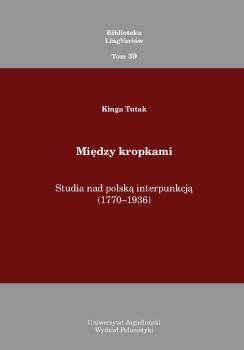Między kropkami: Studia nad polską interpunkcją (1770–1936)
Keywords:
18th to 20th century, development of Polish punctuation, grammar textbooks, rhetorical-intonational punctuation, spelling rules, syntacticlogical punctuationSynopsis
BETWEEN THE DOTS: STUDIES ON POLISH PUNCTUATION (1770–1936)
The present work concerns old punctuation, and as such is a return to the research thread introduced in my book on Old Polish dedicatory works (Tutak 2013a). This monograph is based on studies of Polish punctuation published over a period of more than 150 years. During this time, rhetorical intonational punctuation was replaced by syntactic-logical punctuation to which contemporary Polish speakers are accustomed. The research corpus consists of four sets of sources which are: treatises devoted entirely to the art of punctuation, grammar textbooks, collections of spelling rules, and the two oldest linguistic journals, “Poradnik Językowy” and “Język Polski”. The assumption to discuss the development of Polish punctuation thought based on four separate groups of documents, determined the composition of this study. The first chapter concerns punctuation treatises from the 19th and early 20th century, i.e. the works of Feliks Bentkowski, Florian Łagowski, and Wiktor Wąsik. Completing it is an anlysis of the author’s punctuation in W. Wąsik’s memoirs from the occupation period. In the second chapter I dealt with grammars from the end of the 18th century to the 1930s, while the third chapter considers spelling rules in the 19th and early 20th century. The fourth chapter of the book aims to indicate the important role of Stanisław Jodłowski and his “Zasady interpunkcji” [“Principles of punctuation”] in the codification and unification of punctuation rules in 1935 and 1936. The fifth chapter is devoted to two selected punctuation marks, the colon and the quotation mark. While the quotation mark has attracted the attention of researchers, and not only linguists, the colon has not enjoyed the same interest of linguists as the comma, semicolon, dash, and others. Meanwhile, it was the colon that occupied a unique position among the marks of the old rhetoricalintonational punctuation. With the grammaticalization of punctuation, the colon began to lose its status as a multifunctional mark, which can be traced both in various editions of a specific text, and in normative studies. Particularly interesting in terms of changes in the functioning of the colon in old texts were examples from literary works used as illustration by the authors of punctuation treatises, grammar textbooks, and spelling rules. Chapter six closes the main part of the book, presenting the results of the analysis of the content of “Poradnik Językowy” and “Język Polski” which I scoured for papers devoted to punctuation. The main part of the book is accompanied by and “Orthographic annex” in which I examine the dispute over spelling in the 1930s. The relationship between punctuation and orthography was attested in the oldest Polish grammar textbooks and spelling rules, and sanctioned by the codification in 1935 and 1936. I focused on statements concerning the spelling reform initiated by the Polish Academy of Sciences, especially by the Orthographic Committee established by the Academy.
Chapters
-
TABLE OF CONTENTS
-
CZĘŚĆ I. W POSZUKIWANIU ŹRÓDŁA POLSKIEJ MYŚLI INTERPUNKCYJNEJ – OD WALENTEGO SZYLARSKIEGO DO STANISŁAWA JODŁOWSKIEGO
-
Rozdział 1. W stronę teorii interpunkcji – traktaty interpunkcyjne XIX i początku XX wieku .......... 15
-
Rozdział 2. W stronę praktyki interpunkcyjnej – podręczniki gramatyki od końca XVIII do początku XX wieku .......... 41
-
Rozdział 3. Interpunkcja a prawidła pisowni w XIX i na początku XX wieku .......... 83
-
Rozdział 4. Stanisław Jodłowski jako twórca zasad współczesnej polskiej interpunkcji .......... 119
-
CZĘŚĆ II. O DWUKROPKU I CUDZYSŁOWIE TUDZIEŻ O INNYCH ZNAKACH PISARSKICH W „PORADNIKU JĘZYKOWYM” I „JĘZYKU POLSKIM”
-
Rozdział 5. Funkcje dwukropka i cudzysłowu w polskich opracowaniach dotyczących interpunkcji (1770‒1936) .......... 141
-
Rozdział 6. O znakach pisarskich na łamach „Poradnika Językowego” i „Języka Polskiego” .......... 167
-
CZĘŚĆ III. ANEKS ORTOGRAFICZNY
-
Głosy reformistów i Reytanów obecnej pisowni w walce o ortografię 1935 i 1936 roku .......... 199





